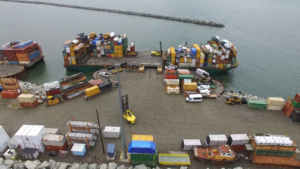American ports are currently receiving massive amounts of funding from the federal government for much-needed and long-overdue upgrades. The country’s port infrastructure is a critical component of America’s global competitiveness, and the funding will target critical needs that must be met immediately. As the ports are modernized and expanded, new collaborative projects will be launched weekly…all with very large budgets.
The US Department of Transportation (USDOT) announced earlier this summer that in 2022 alone, $684 million in federal funding is available for projects linked to coastal seaports, inland river ports, and ports along the Great Lakes. This new funding is the largest amount of investment capital ever committed through the Port Infrastructure Development Program.
One component of the new funding is interesting. Funded projects are required to proceed quickly and there is a mandate that construction phases should be scheduled no later than eighteen months after funding has been allocated. Many ports have already completed the planning phases for projects.

Image courtesy of Nome, Alaska
Port officials will spend $200 million to modernize the Anchorage-based Port of Alaska. State funding of $100 million will be leveraged to match $100 million in federal funds. The plan for this modernization effort outlines the beginning stages of a northward extension of the port. Over the next several years, the initiative carries an anticipated total cost of $2 billion.
Alaska’s Port of Nome, the only US deep-water Arctic port, has funding for projects to improve efficiency and expand capacity. Port officials will oversee the initial groundwork required to accommodate larger volumes and sizes of vessels transiting the nearby Bering Strait. Upcoming projects include reducing the port’s limitations, increasing dock space, and widening navigation channels. Cost estimations for the overall effort have been placed at $491 million.
Tacoma Harbor officials will spend hundreds of millions to improve a state of Washington port that serves as a critical gateway between Asia and large swathes of the US. The US Army Corps of Engineers recently released a final feasibility report and work to deepen and widen an existing channel will begin soon. At least 950,000 cubic yards of dredged material will be moved and an estimated price tag of $295 million has been attached for this modernization effort.
A large project designed to bolster operational efficiency at Port Angeles in Washington state is entering its second stage of development. The port allocated $4 million for the design work required for the next round of projects and that design phase will be finalized this year. The current conceptual plan adds an abundance of new work space that will allow the port to provide services for vessels up to 180 feet in length and 35 feet wide. Construction work on the project has an anticipated cost in excess of $10 million.
The Port of San Francisco will use the federal funding for multimodal improvements with a goal of efficiently transporting goods through the bay area while minimizing negative impacts on local communities. A major element of this improvement plan is the port’s Resilient Multi-Modal Cargo Way project, which is entering its final design stage. This overall initiative is expected to cost between $30 million and $50 million.
Several improvements in various stages of development will revamp the nearby Port of Oakland over the next several years. A feasibility study is currently underway and it should be completed in 2023. The projects that result will be related to the goals of accommodating larger modern vessels and reducing transit inefficiencies. The cumulative cost carries a price tag of $440 million.
Officials at the Port of Oakland are directing millions of dollars to projects that will deliver the next generation of technology. The initiative includes a $2.5 million project to install new electric vehicle charging stations and a $600,000 project for cyber artificial intelligence (AI) technology that will monitor and detect potential risks to port operations.
In Wisconsin, county, state, and port officials are working together to launch a redevelopment initiative for the Port of Green Bay. The goal is to expand and modernize one of Lake Michigan’s busiest ports. The project will include significant work on a former power plant situated at the port, construction of a new dock, elevating the entire site above the flood plain, and creating a new state-of-the-art terminal. Officials will spend $25 million to jump-start this modernization effort.
In June, Missouri’s Department of Transportation approved initial funding for development of a new multimodal port on the Mississippi River. The early funding will allow the Hannibal Regional Port Authority to purchase 85 acres of prime industrial land in Taylor, Missouri. Once that has been completed, work will begin to construct a new public port between St. Louis, Missouri and Quad Cities, Iowa with truck, rail, and river services. A projected cost of $17 million has been announced and the design stage will be completed before the end of 2022.
As America’s ports modernize, expand, add new technology and increase service capabilities, there will be hundreds of public-private partnering opportunities. Port projects with nine and ten figure budgets are emerging and contractors will be in high demand along America’s coastlines and in regions where there are inland waterways.






